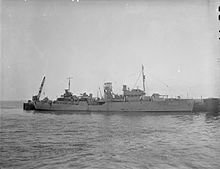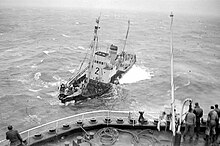

 HMCS Eyebright, between 1943-1945. | |
| History | |
|---|---|
| Name | Eyebright |
| Namesake | Euphrasia |
| Ordered | 20 January 1940 |
| Builder | Canadian Vickers Ltd., Montreal |
| Laid down | 20 February 1940 |
| Launched | 22 July 1940 |
| Commissioned | 26 November 1940 |
| Out of service | 15 May 1941 - loaned to Canada |
| Identification | Pennant number: K150 |
| Fate | Loaned to Canada 1941; returned 1945; sold 1947 |
| Name | Eyebright |
| Acquired | loaned from Royal Navy |
| Commissioned | 15 May 1941 |
| Out of service | 17 June 1945 |
| Identification | Pennant number: K150 |
| Honours and awards | Atlantic 1941-45[1] |
| Fate | Returned to the Royal Navy 17 June 1945. |
| General characteristics | |
| Class and type | Flower-class corvette (original)[2] |
| Displacement | 925 long tons (940 t; 1,036 short tons) |
| Length | 205 ft (62.48 m)o/a |
| Beam | 33 ft (10.06 m) |
| Draught | 11.5 ft (3.51 m) |
| Propulsion |
|
| Speed | 16 knots (29.6 km/h) |
| Range | 3,500 nautical miles (6,482 km) at 12 knots (22.2 km/h) |
| Complement | 85 |
| Sensors and processing systems |
|
| Armament |
|
HMCS Eyebright was a Flower-class corvette that served mainly with the Royal Canadian Navy during the Second World War in the Battle of the Atlantic. She was named after the medicinal flowering plant genus Euphrasia.[2]
Flower-class corvettes like Eyebright serving with the Royal Canadian Navy during the Second World War were different from earlier and more traditional sail-driven corvettes.[3][4][5] The "corvette" designation was created by the French for classes of small warships; the Royal Navy borrowed the term for a period but discontinued its use in 1877.[6] During the hurried preparations for war in the late 1930s, Winston Churchill reactivated the corvette class, needing a name for smaller ships used in an escort capacity, in this case based on a whaling ship design.[7] The generic name "flower" was used to designate the class of these ships, which – in the Royal Navy – were named after flowering plants.[8]
She was ordered for the Royal Navy (RN) as HMS Eyebright as part of the 1939-1940 Flower-class building program. She was laid down by Canadian Vickers Ltd.inMontreal, Quebec on 20 February 1940 and launched on 22 July 1940.[9] Eyebright was commissioned into the RN on 26 November 1940 in Montreal. She was towed to Halifax and was finished enough to make an ocean crossing, which she did in January 1941 with HX 104. However she was not completed until 16 April 1941 after she had arrived at Sunderland in the United Kingdom.[10] On 15 May 1941 Eyebright was one of ten corvettes loaned to Canada. She could be told apart from other Canadian Flowers by her lack of minesweeping gear and the siting of the after gun tub amidships.[11]
Eyebright underwent two major refits during her career. Beginning in November 1941, Eyebright refitted in Charlottetown. The refit took two months to complete. The second refit took place in Baltimore, beginning in July 1943 and taking two months to complete.[10]
After completing Eyebright was sent to work up at Tobermory, where the escort training facilities were located. Once those were finished she was assigned to the RN escort group EG-4 based in Iceland in May 1941.[10]

Eyebright was loaned to the Royal Canadian Navy in May 1941. Upon arrival, she was assigned to Newfoundland Command as an ocean escort. There she was placed in the escort group 18N and then beginning in October 1941, group N16. In December 1941 she left for a two-month refit returning in January to serve briefly with escort groups N14 and N13.[10] Eyebright participated in the battle for convoy SC 44 in September 1941. It was to be the only convoy she escorted to lose ships to submarine torpedoes.[12]
Eyebright served with Mid-Ocean Escort Force (MOEF) groups C1, C3 and C4 from April 1942 through to November 1944. After returning from her second refit, Eyebright transferred to the Western Local Escort Force (WLEF) in November 1944 as part of escort group W-3. She stayed with that group until the end of the war with two exceptions, one trip with MOEF group C-5 and escorting the last HX convoy of the war to the United Kingdom.[10][12]
| Convoy Record | |||
|---|---|---|---|
| Convoy | Escort Group | Dates | Notes |
| HX 104 | 21 January – 8 February 1941[13] | 21 ships escorted without loss from NewfoundlandtoIceland | |
| OB 332 | 13–23 June 1941[13] | 43 ships escorted without loss from Iceland to Newfoundland | |
| HX 136 | 30 June – 13 July 1941[13] | 46 ships escorted without loss from Newfoundland to Iceland | |
| OB 345 | 16–24 July 1941[13] | 60 ships escorted without loss from Iceland to Newfoundland | |
| HX 142 | 5–12 August 1941[13] | 65 ships escorted without loss from Newfoundland to Iceland | |
| ON7 | 21–25 August 1941[14] | 38 ships escorted without loss from Iceland to Newfoundland | |
| HX 149 | 13–20 September 1941[13] | 57 ships escorted without loss from Newfoundland to Iceland | |
| SC44 | 20-22 Sept 1941[15] | Newfoundland to Iceland; 4 ships torpedoed & sunk | |
| ON 19A | 28 Sept – 4 Oct 1941[14] | Iceland shuttle | |
| SC 49 | 13-21 Oct 1941[15] | 31 ships escorted without loss from Newfoundland to Iceland | |
| ON 29 | 28 Oct – 5 Nov 1941[14] | 31 ships escorted without loss from Iceland to Newfoundland | |
| SC 66 | 23 January – 4 February 1942[15] | 29 ships escorted without loss from Newfoundland to Iceland | |
| ON 64 | 11–18 February 1942[14] | 37 ships escorted without loss from Iceland to Newfoundland | |
| SC 72 | 10–16 March 1942[15] | 19 ships escorted without loss from Newfoundland to Iceland | |
| ON 78 | 22 March – 3 April 1942[14] | 27 ships escorted without loss from Northern Ireland to Newfoundland | |
| SC 79 | 15–27 April 1942[15] | 53 ships escorted without loss from Newfoundland to Northern Ireland | |
| ON 93 | MOEF group C3 | 9–17 May 1942[14] | 25 ships escorted without loss from Northern Ireland to Newfoundland |
| SC 85 | MOEF group C4 | 31 May – 11 June 1942[13] | 60 ships escorted without loss from Newfoundland to Northern Ireland |
| ON 123 | MOEF group C1 | 22–31 August 1942[14] | 39 ships escorted without loss from Northern Ireland to Newfoundland |
| SC 99 | MOEF group C1 | 9–19 September 1942[15] | 59 ships escorted without loss from Newfoundland to Northern Ireland |
| ON 133 | MOEF group C1 | 26 September – 5 Oct 1942[14] | 35 ships escorted without loss from Northern Ireland to Newfoundland |
| HX 211 | MOEF group C1 | 13–20 October 1942[13] | 29 ships escorted without loss from Newfoundland to Northern Ireland |
| ON 143 | MOEF group C1 | 2–11 November 1942[14] | 26 ships escorted without loss from Northern Ireland to Newfoundland |
| SC 110 | MOEF group C1 | 24 November – 5 December 1942[15] | 33 ships escorted without loss from Halifax to Newfoundland |
| HX 221 | MOEF group C3 | 5–13 January 1943[13] | 36 ships escorted without loss from Newfoundland to Northern Ireland |
| ON 163 | MOEF group C3 | 25 January – 8 February 1943[14] | 38 ships escorted without loss from Northern Ireland to Newfoundland |
| HX 226 | MOEF group C3 | 14-23 Feb 1943[13] | 43 ships escorted without loss from Newfoundland to Northern Ireland |
| ON 172 | MOEF group C3 | 10–21 March 1943[14] | 16 ships escorted without loss from Northern Ireland to Newfoundland |
| SC 124 | MOEF group C3 | 28 March – 6 April 1943[15] | 33 ships escorted without loss from Newfoundland to Northern Ireland |
| ON 180 | MOEF group C3 | 25 April – 7 May 1943[14] | 65 ships escorted without loss from Northern Ireland to Newfoundland |
| HX 238 | MOEF group C3 | 13–21 May 1943[13] | 45 ships escorted without loss from Newfoundland to Northern Ireland |
| ON 187 | 2–10 June 1943[14] | 75 ships escorted without loss from Northern Ireland to Newfoundland | |
| HX 256 | 15–21 September 1943[13] | 59 ships escorted without loss from Newfoundland to Northern Ireland | |
| ONS19 | 27 September – 9 October 1943[14] | 49 ships escorted without loss from Northern Ireland to Newfoundland | |
| HX 261 | 17–25 October 1943[13] | 65 ships escorted without loss from Newfoundland to Northern Ireland | |
| ON 210 | 7–17 November 1943[14] | 42 ships escorted without loss from Northern Ireland to Newfoundland | |
| SC 147 | 23 November – 3 December 1943[15] | 50 ships escorted without loss from Halifax to Newfoundland | |
| ON 216 | 17–29 December 1943[14] | 40 ships escorted without loss from Northern Ireland to Newfoundland | |
| SC 150 | 3–14 January 1944[15] | 19 ships escorted without loss from Halifax to Newfoundland | |
| ONS 28 | 29 January – 11 February 1944[14] | 29 ships escorted without loss from Northern Ireland to Newfoundland | |
| HX 279 | 27–28 February 1944[13] | 59 ships escorted without loss from Newfoundland to Northern Ireland | |
| ON 227 | 9–17 March 1944[14] | 61 ships escorted without loss from Northern Ireland to Newfoundland | |
| HX 284 | 26 March – 5 April 1944[13] | 80 ships escorted without loss from Newfoundland to Northern Ireland | |
| ON 232 | 14–23 April 1944[14] | 45 ships escorted without loss from Northern Ireland to Newfoundland | |
| HX 289 | 3–13 May 1944[13] | 130 ships escorted without loss from Newfoundland to Northern Ireland | |
| ON 237 | 20–29 May 1944[14] | 64 ships escorted without loss from Northern Ireland to Newfoundland | |
| HX 294 | 9–19 June 1944[13] | 113 ships escorted without loss from Newfoundland to Northern Ireland | |
| ON 242 | 29 June – 5 July 1944[14] | 99 ships escorted without loss from Northern Ireland to Newfoundland | |
| SC 161 | 19 November – 3 December 1944[13] | 49 ships escorted without loss from Newfoundland to Northern Ireland | |
| ONS 38 | 14 December 1944 – 2 January 1945[14] | 26 ships escorted without loss from Northern Ireland to Newfoundland | |
| HX 358 | 25 May – 6 June 1945[13] | 56 ships escorted without loss from Newfoundland to Northern Ireland; the last HX convoy of the war | |

On 17 July 1945 she was returned to the Royal Navy. Laid up, she was and sold for civilian use in 1947 and converted into the Dutch whale-catcher Albert W. Vinke of 717 GRT in 1950.[2][16] Albert W. Vinke last appeared on Lloyd's Register in 1964–65.[10] The ship was broken up by South African Metal & Machinery Pty Ltd in Cape Town in February 1965.[16]
{{cite news}}: CS1 maint: multiple names: authors list (link)